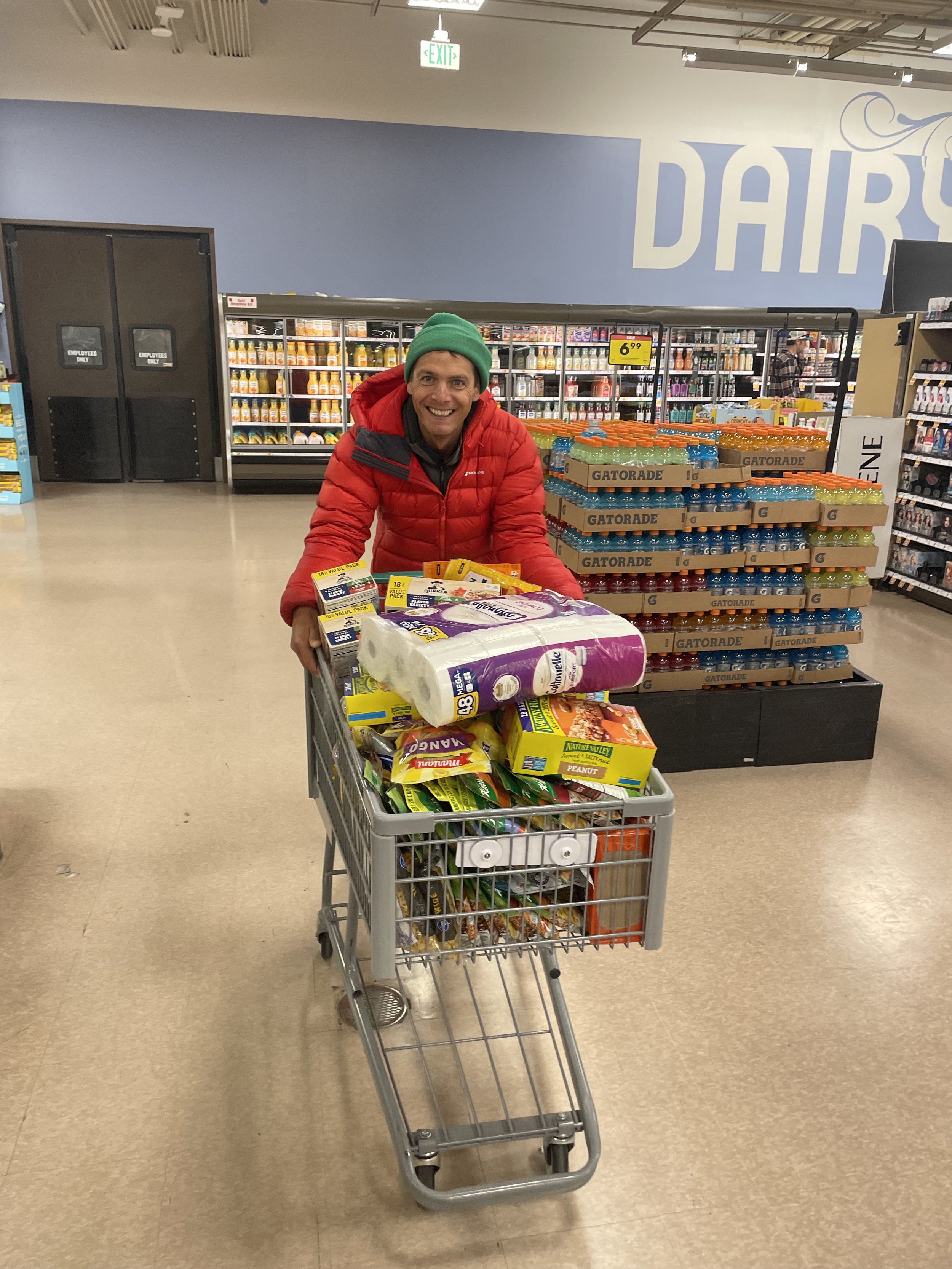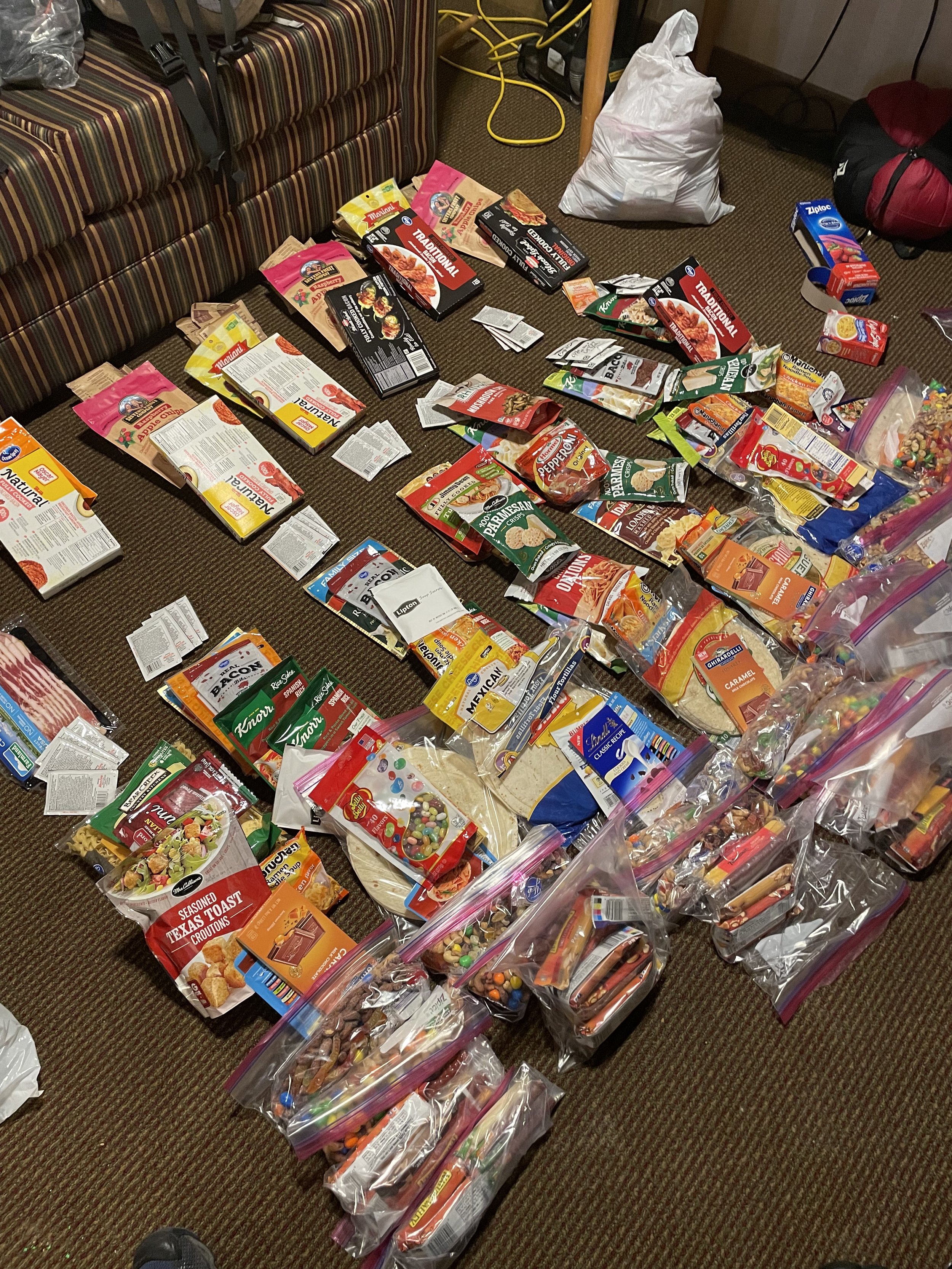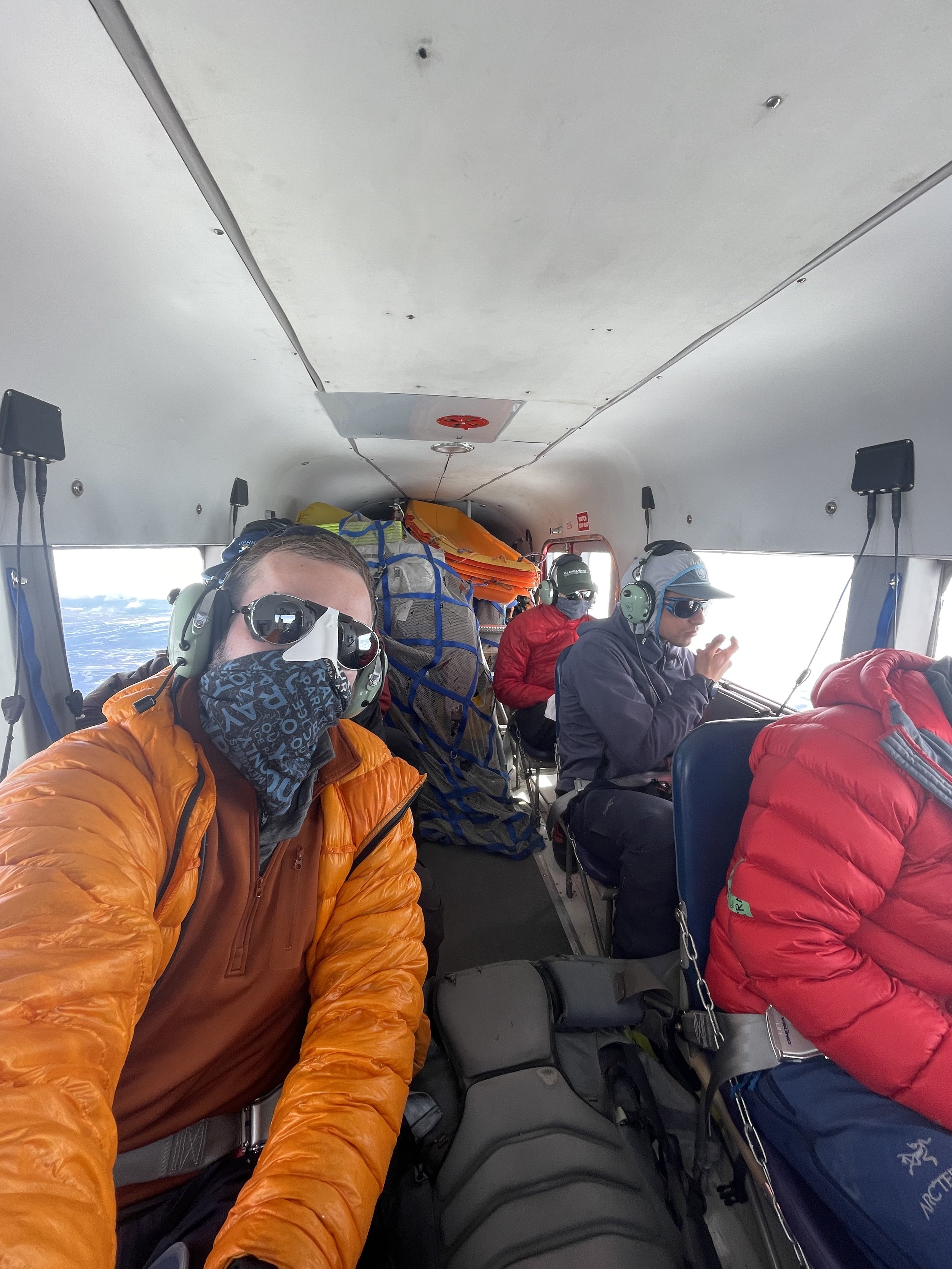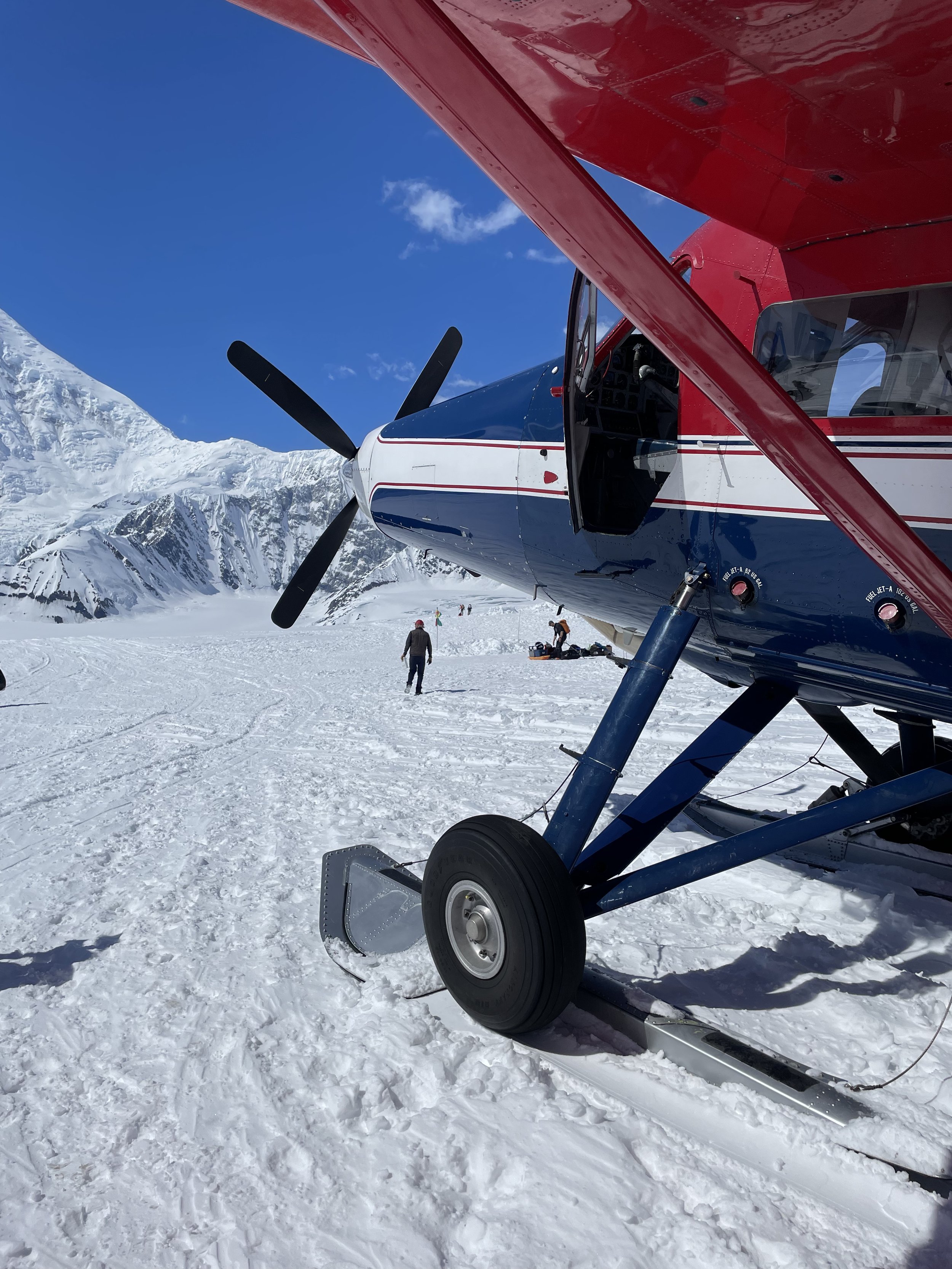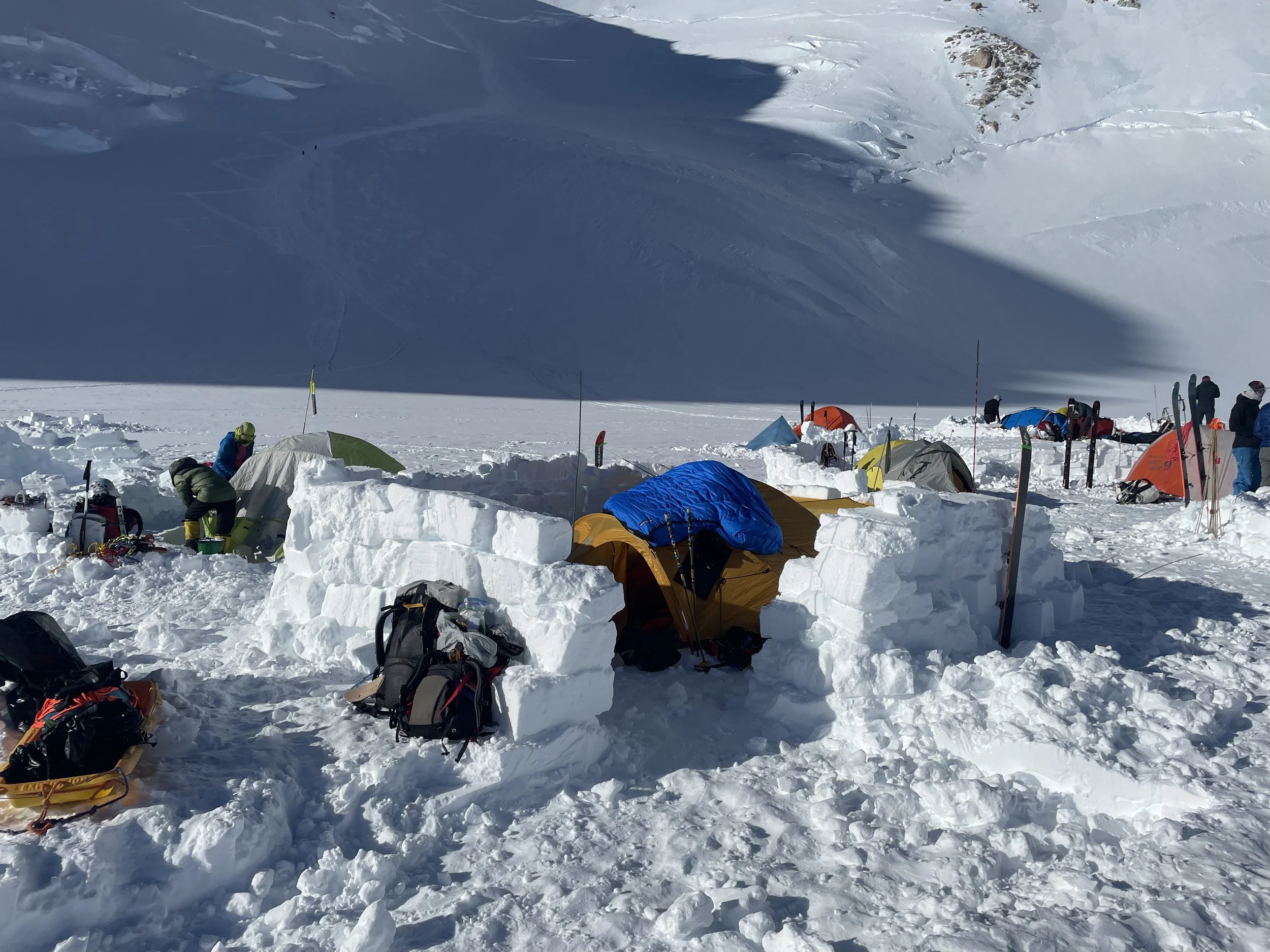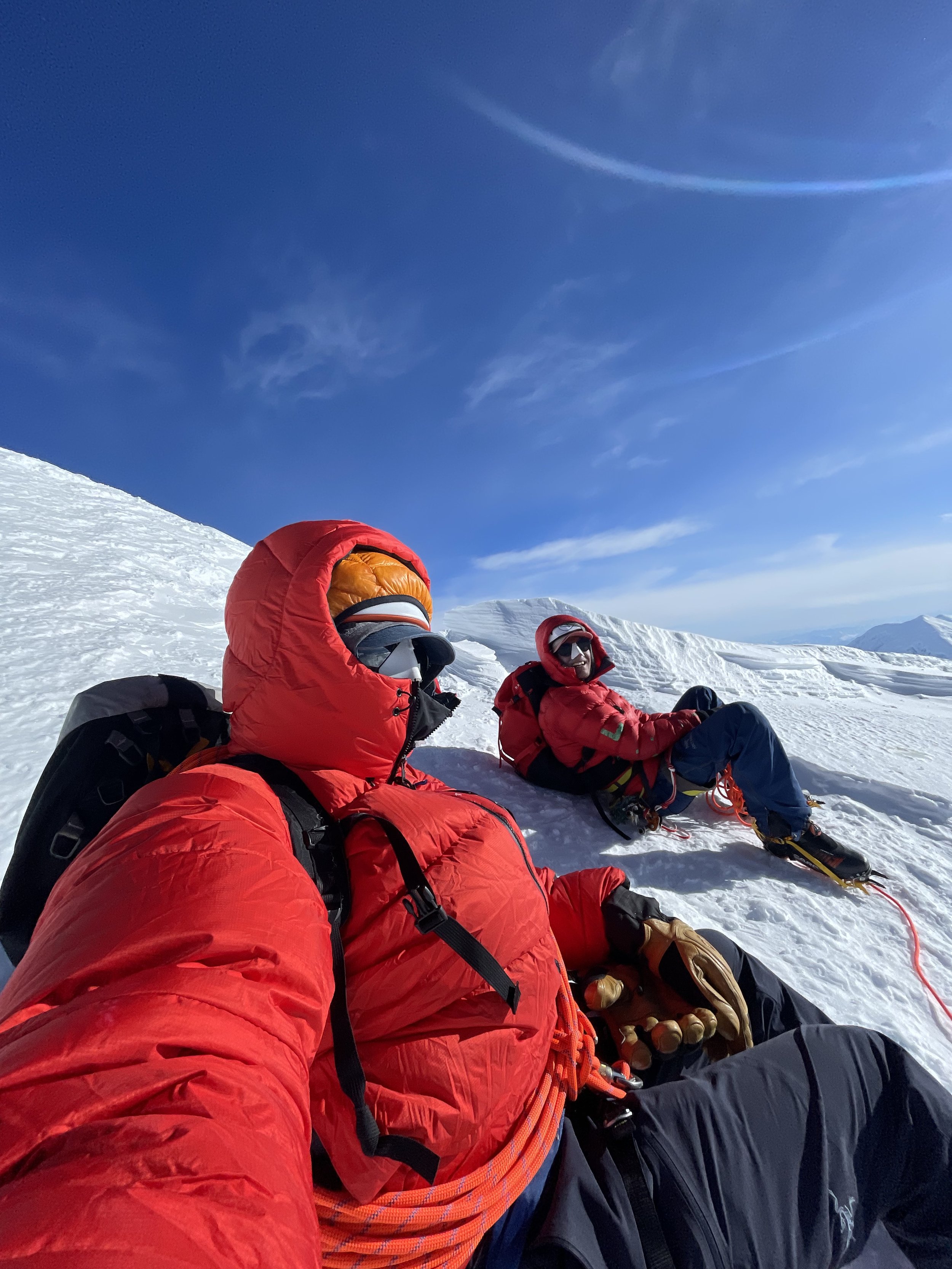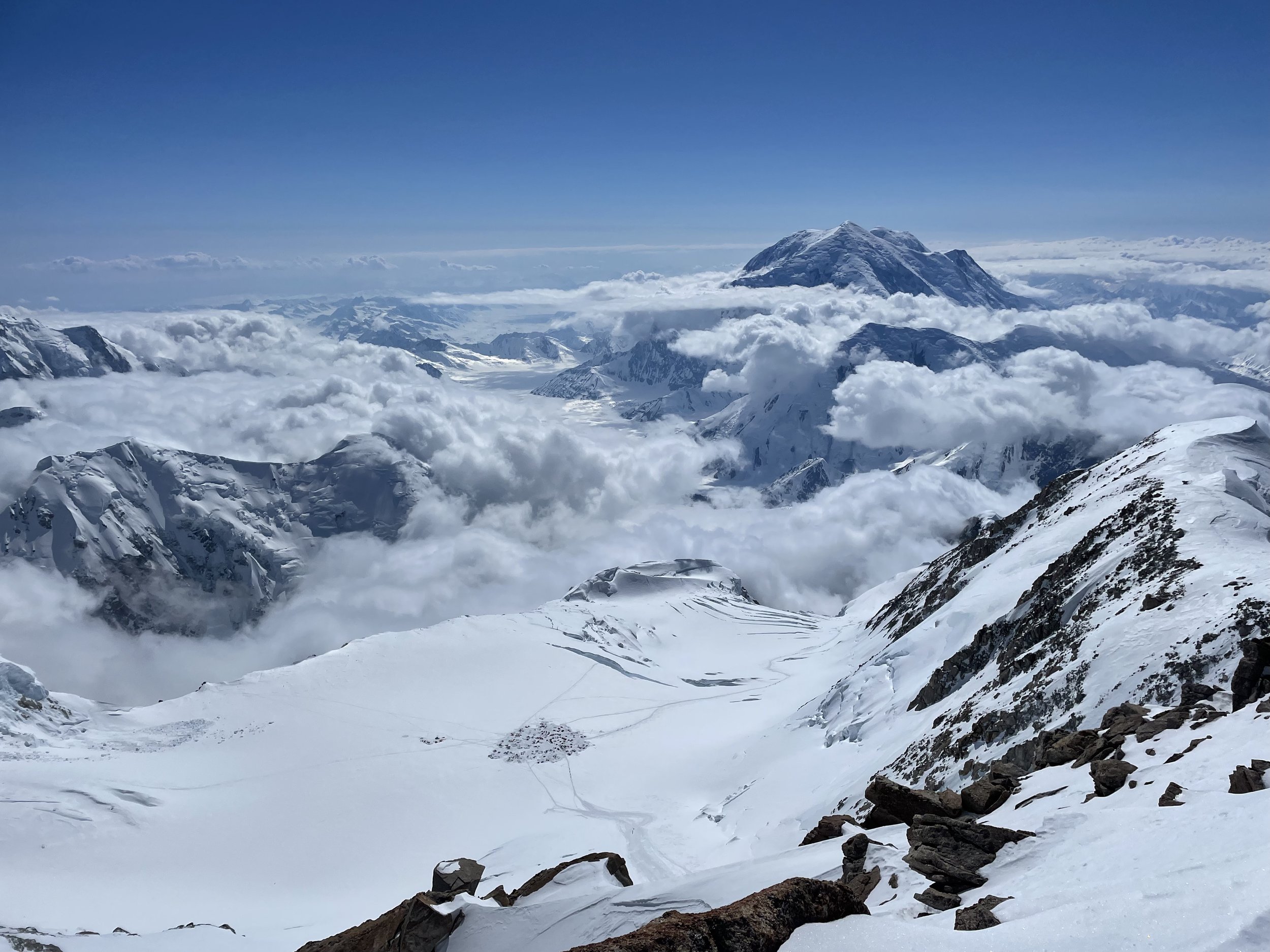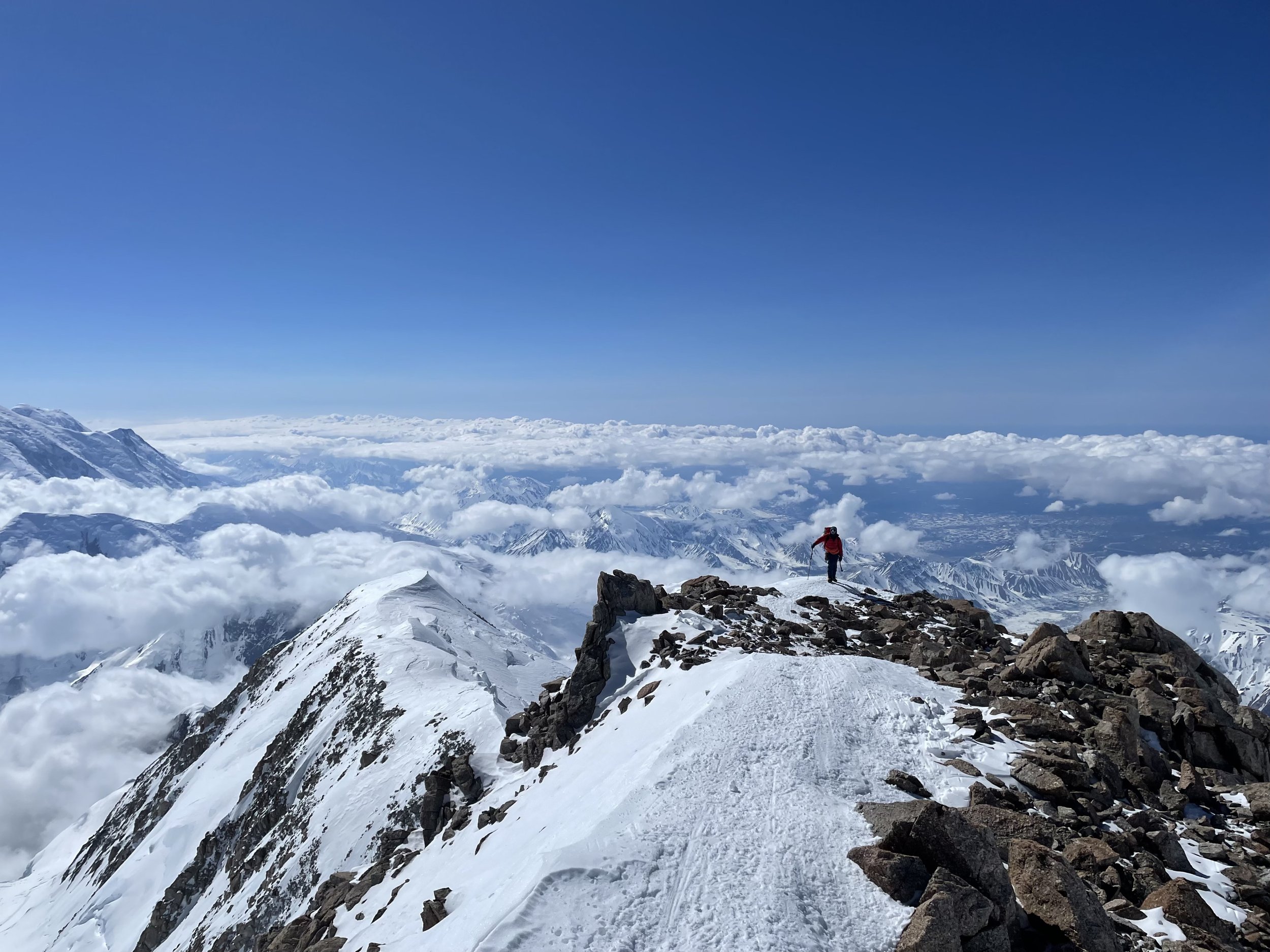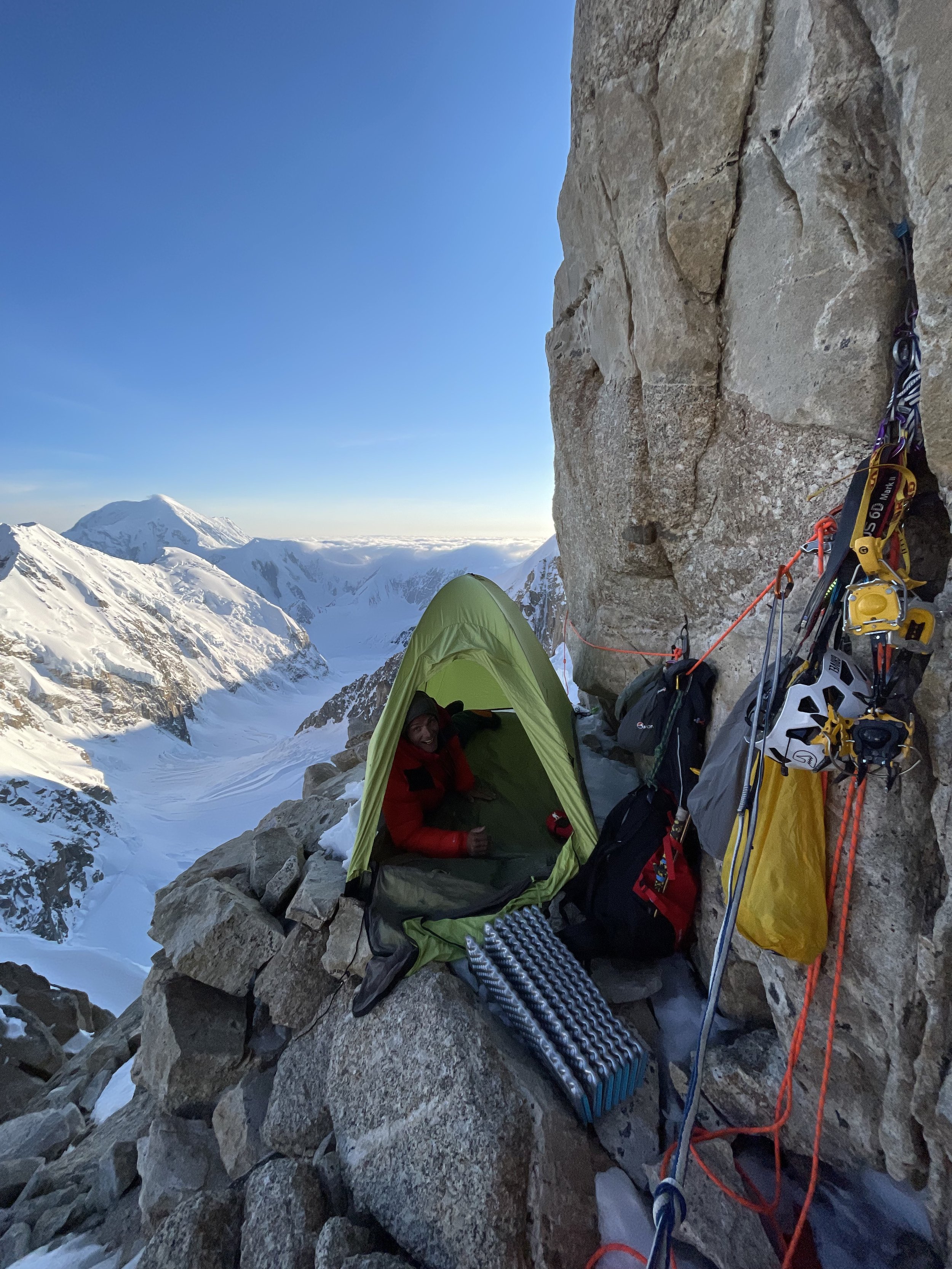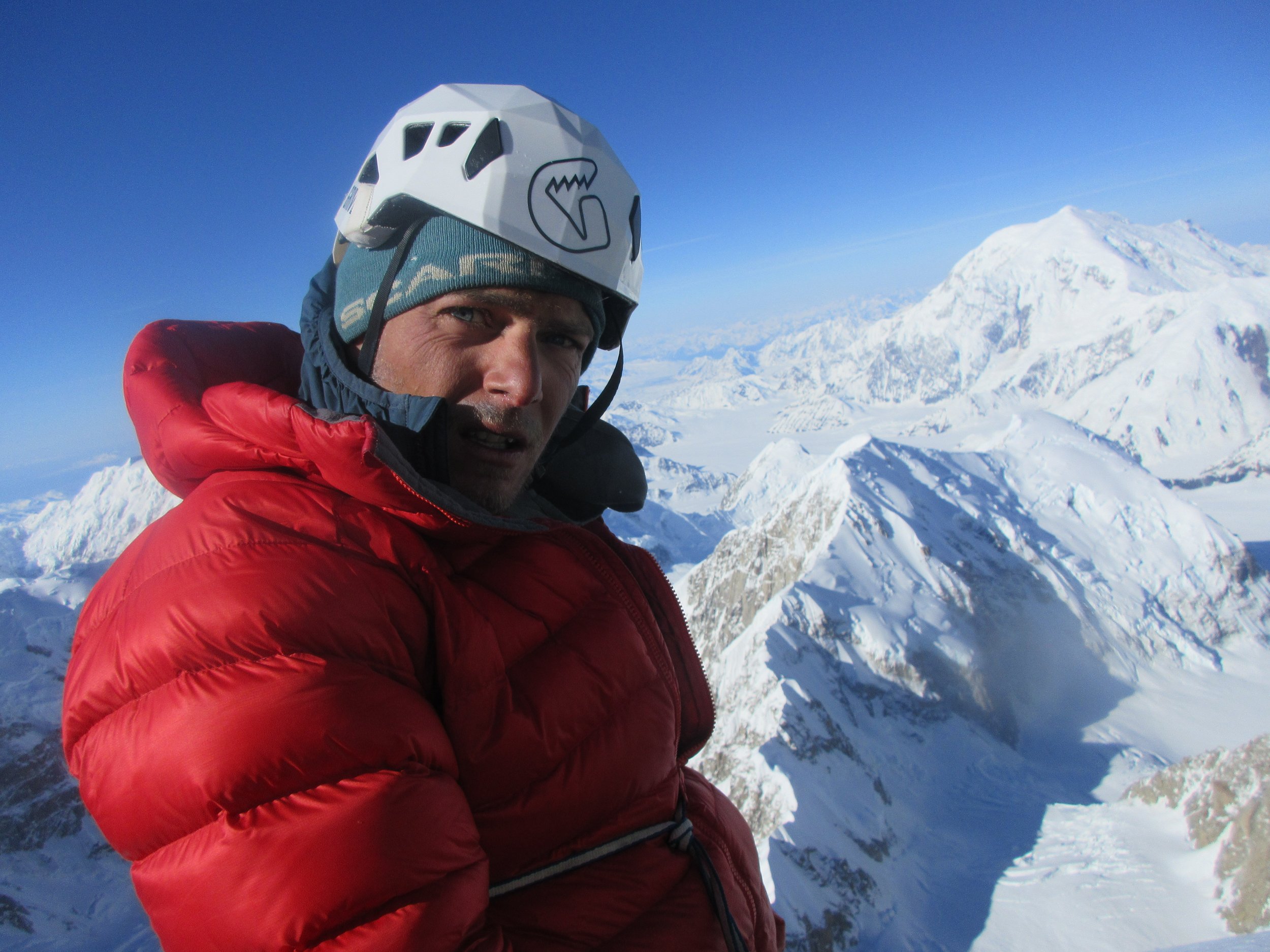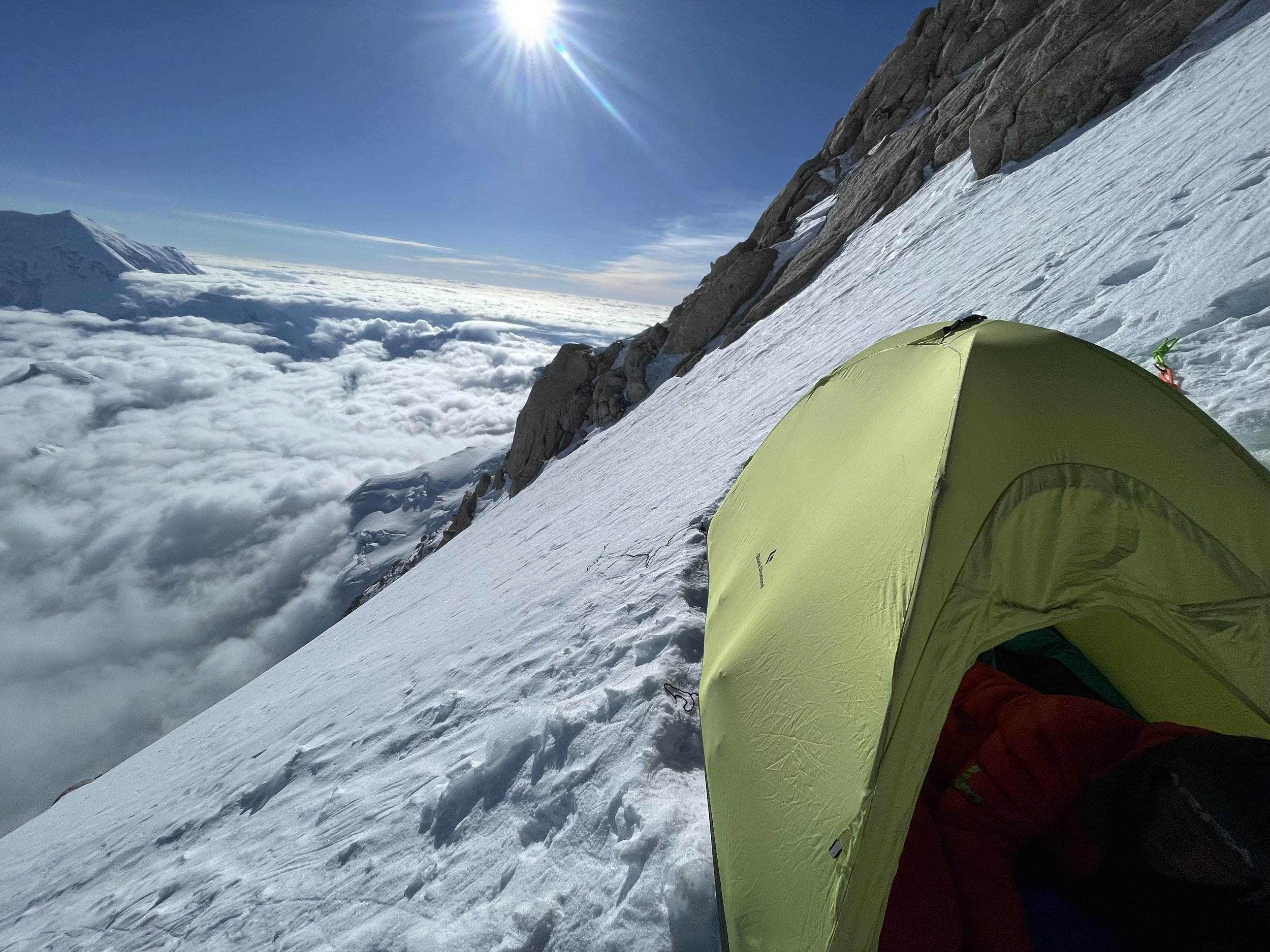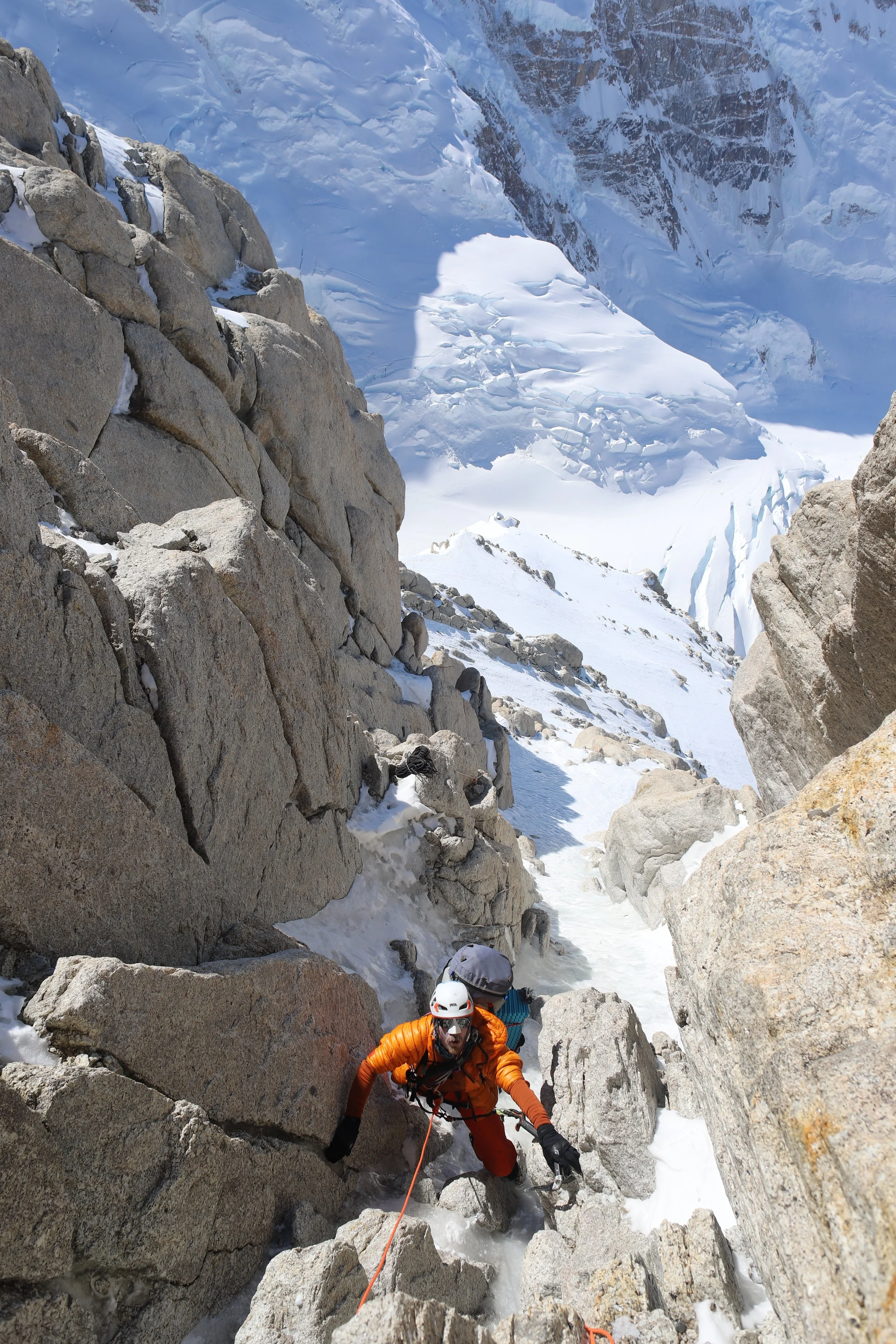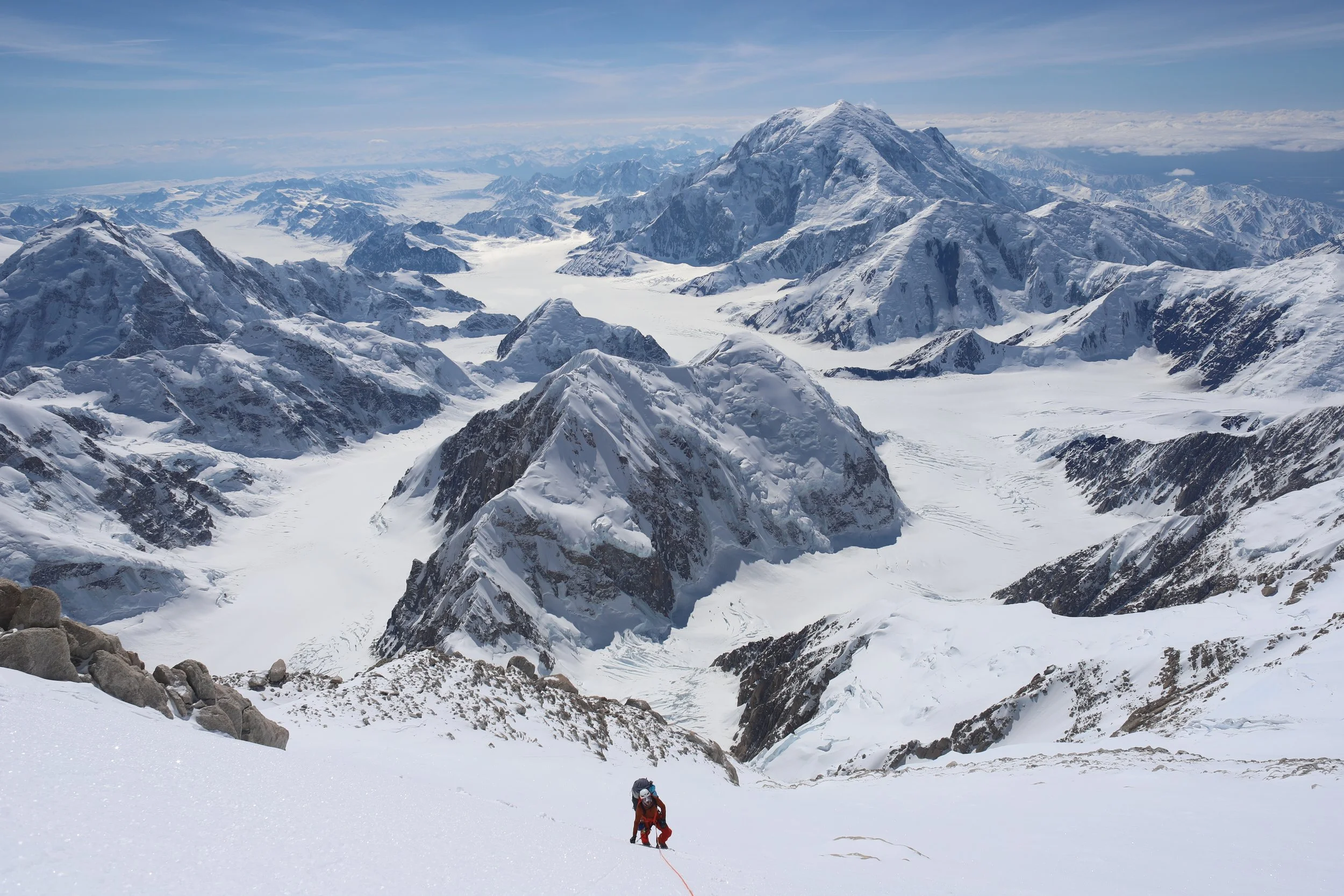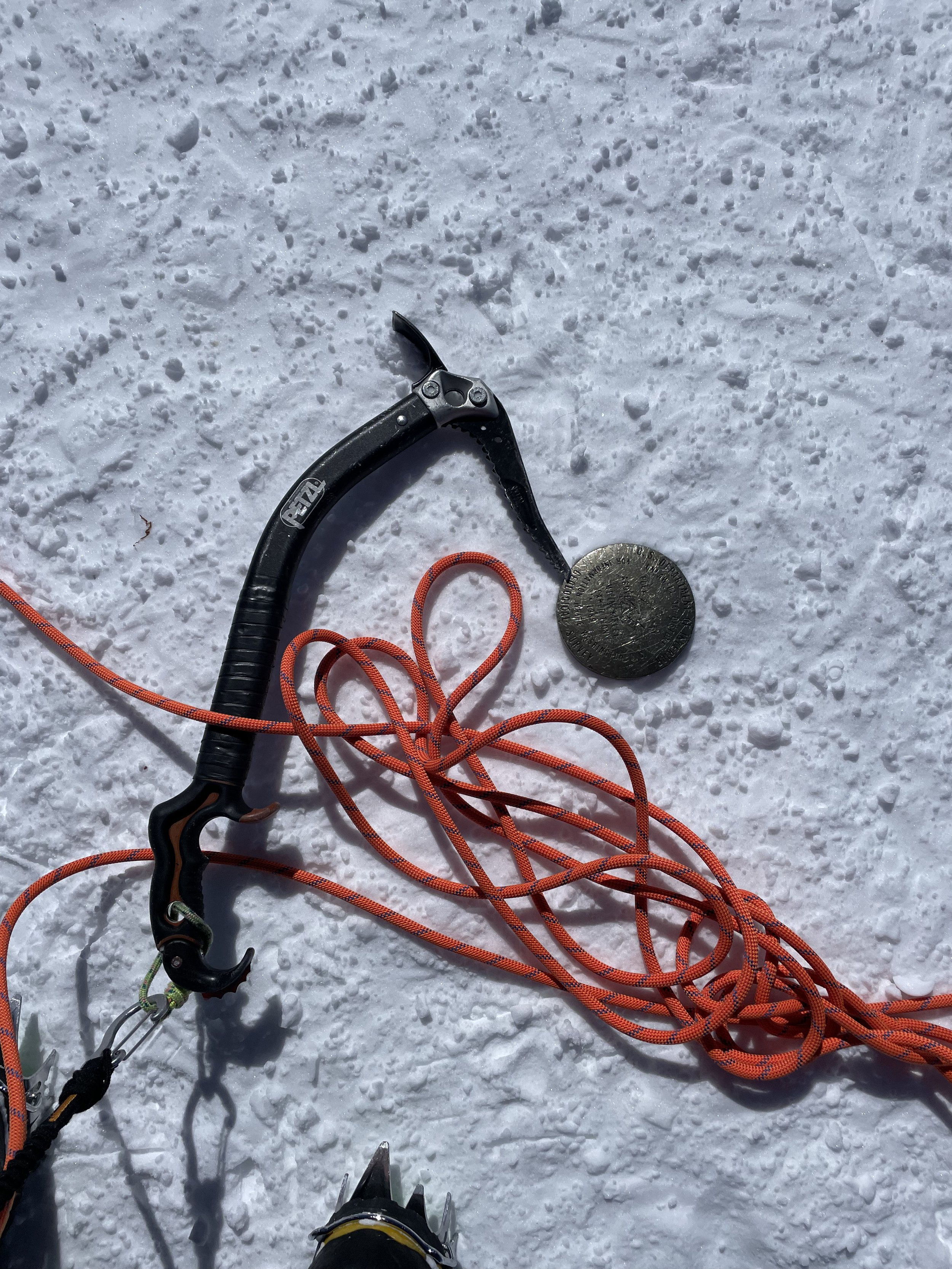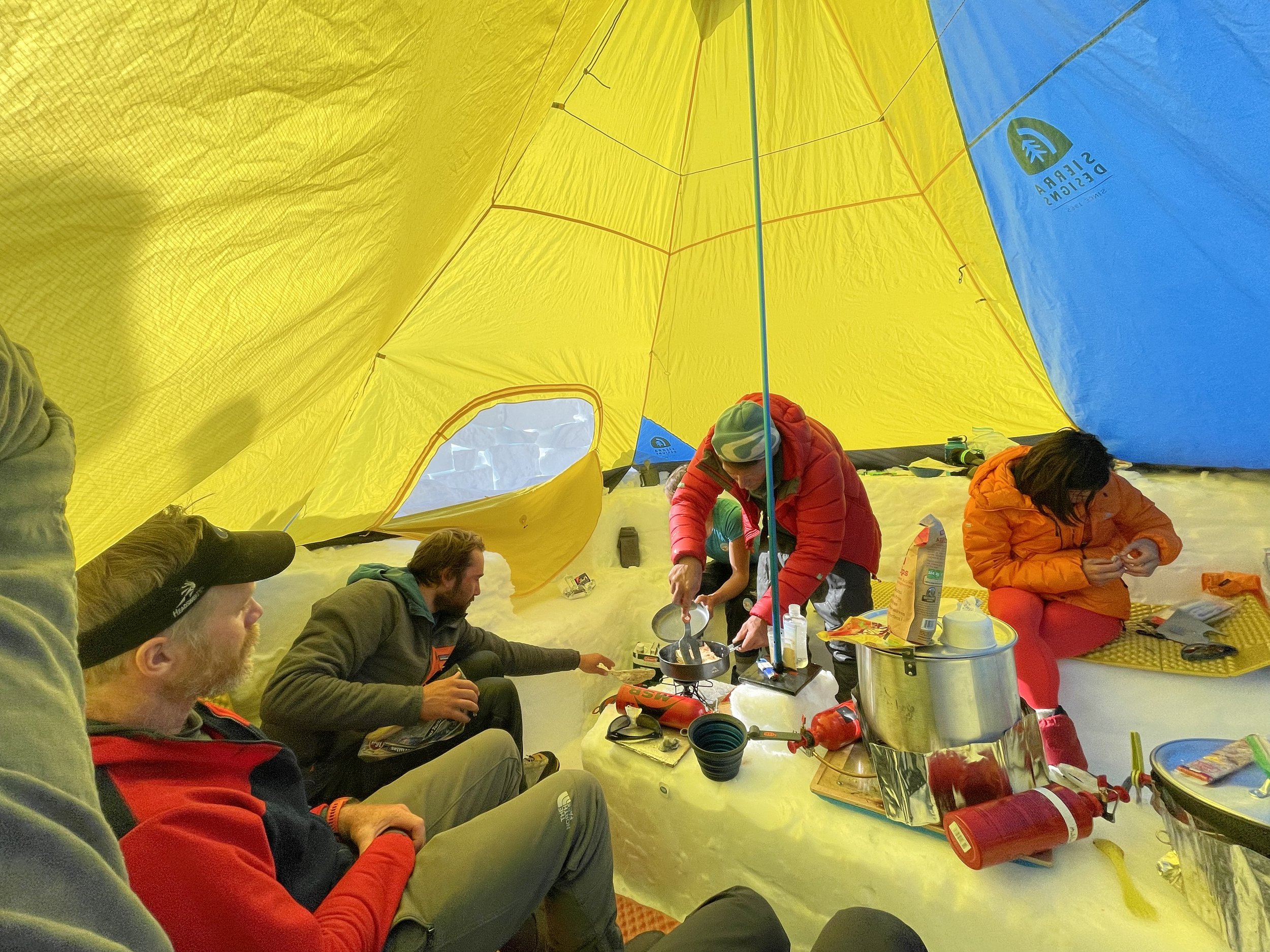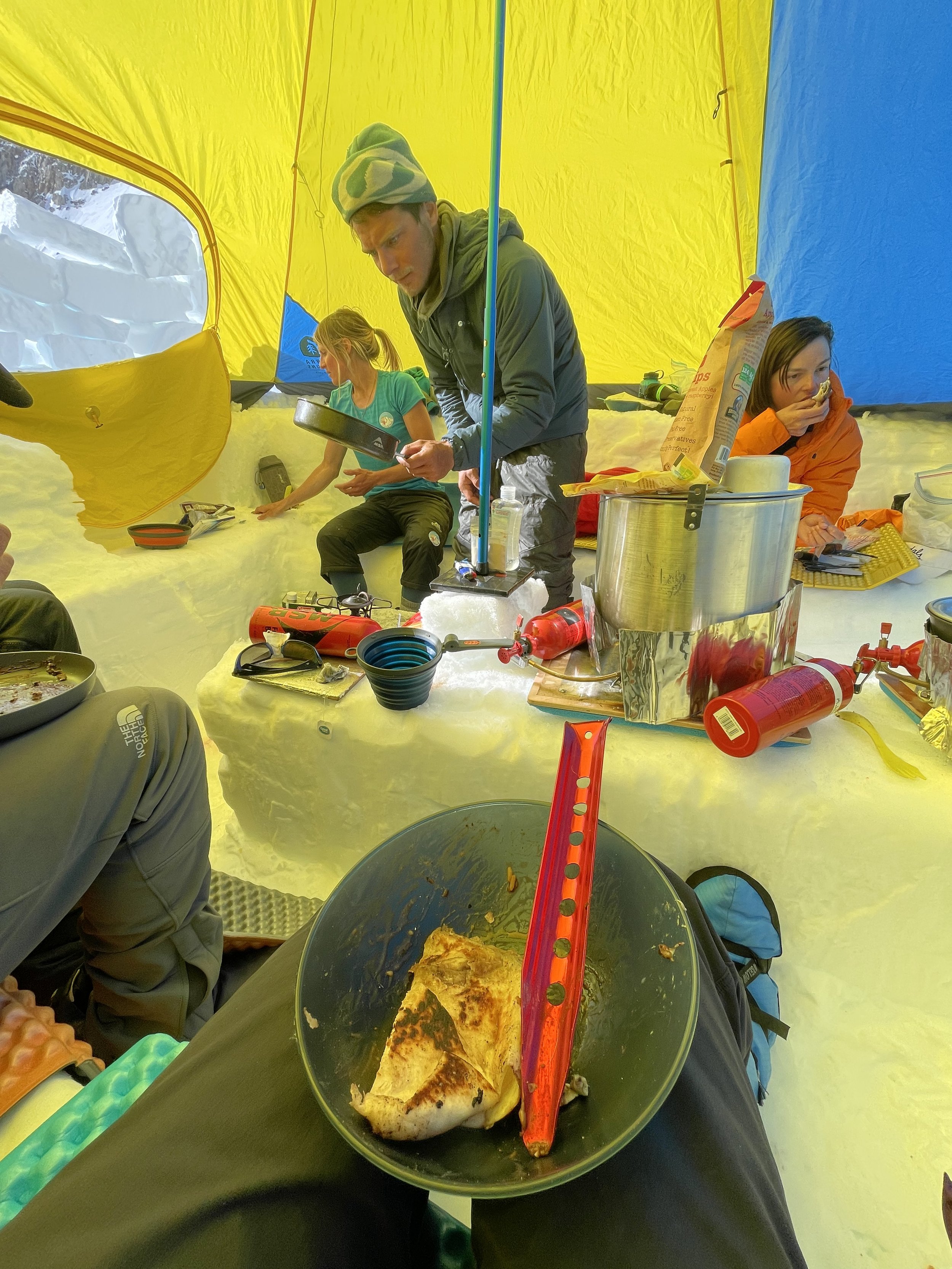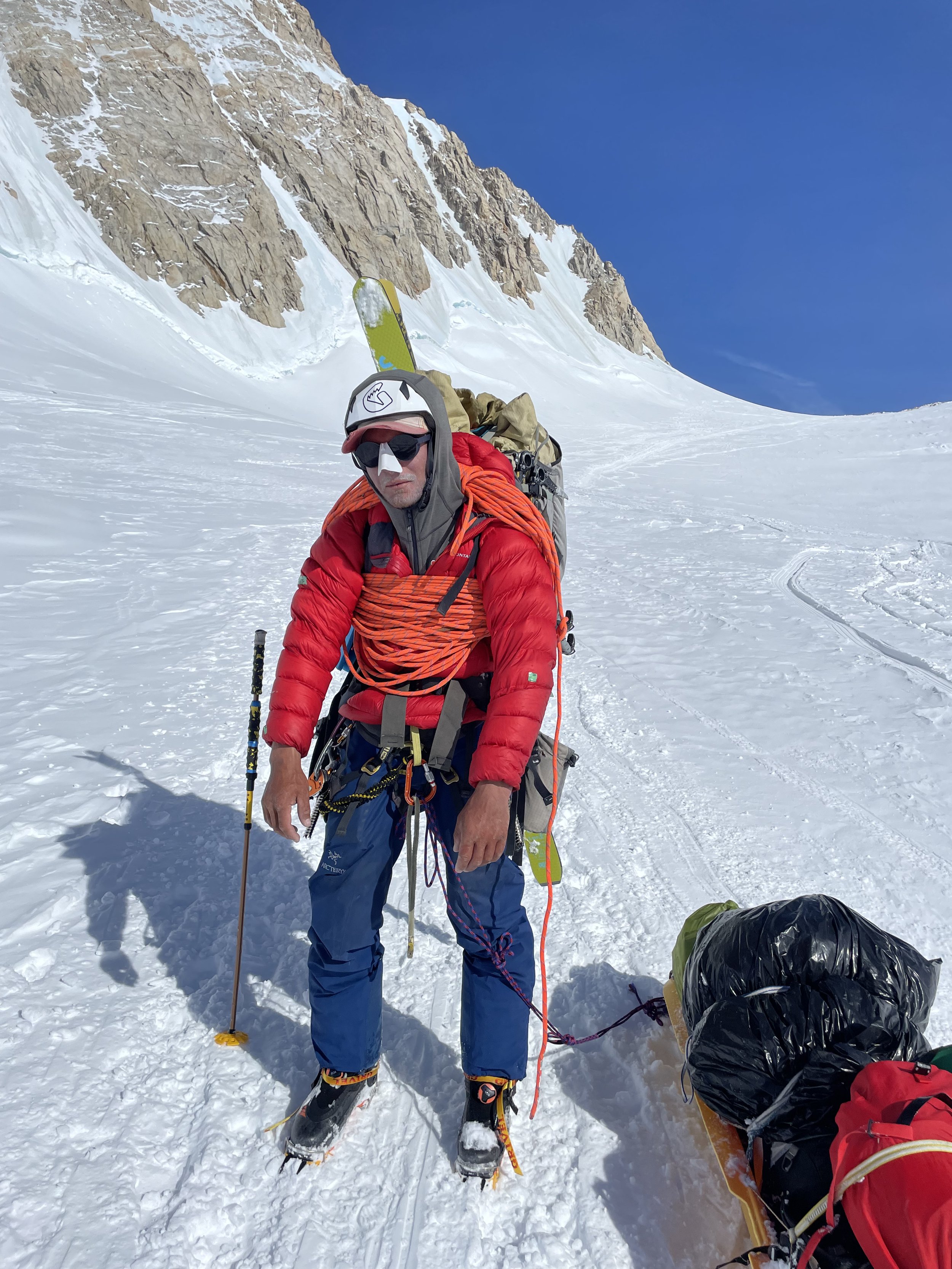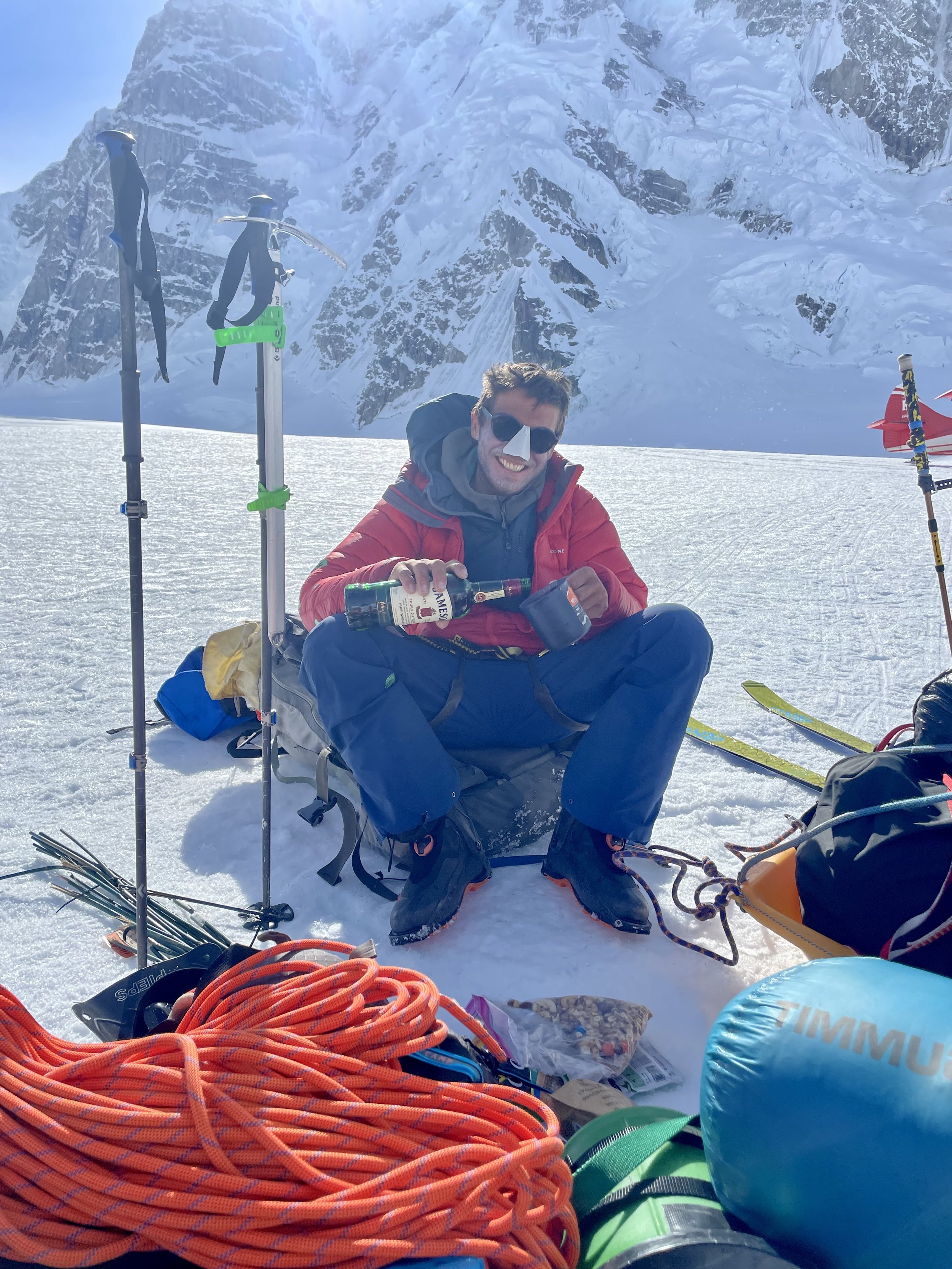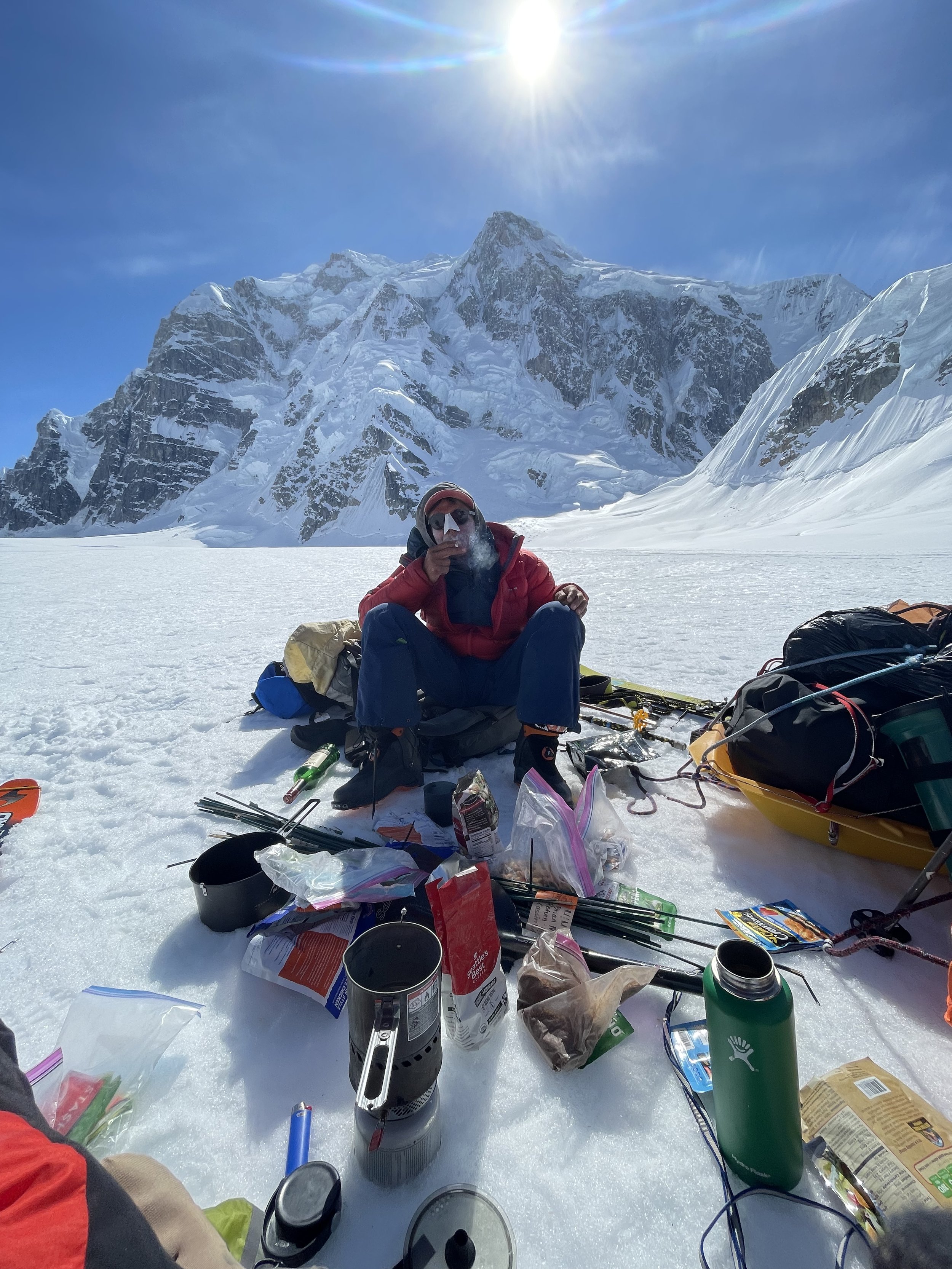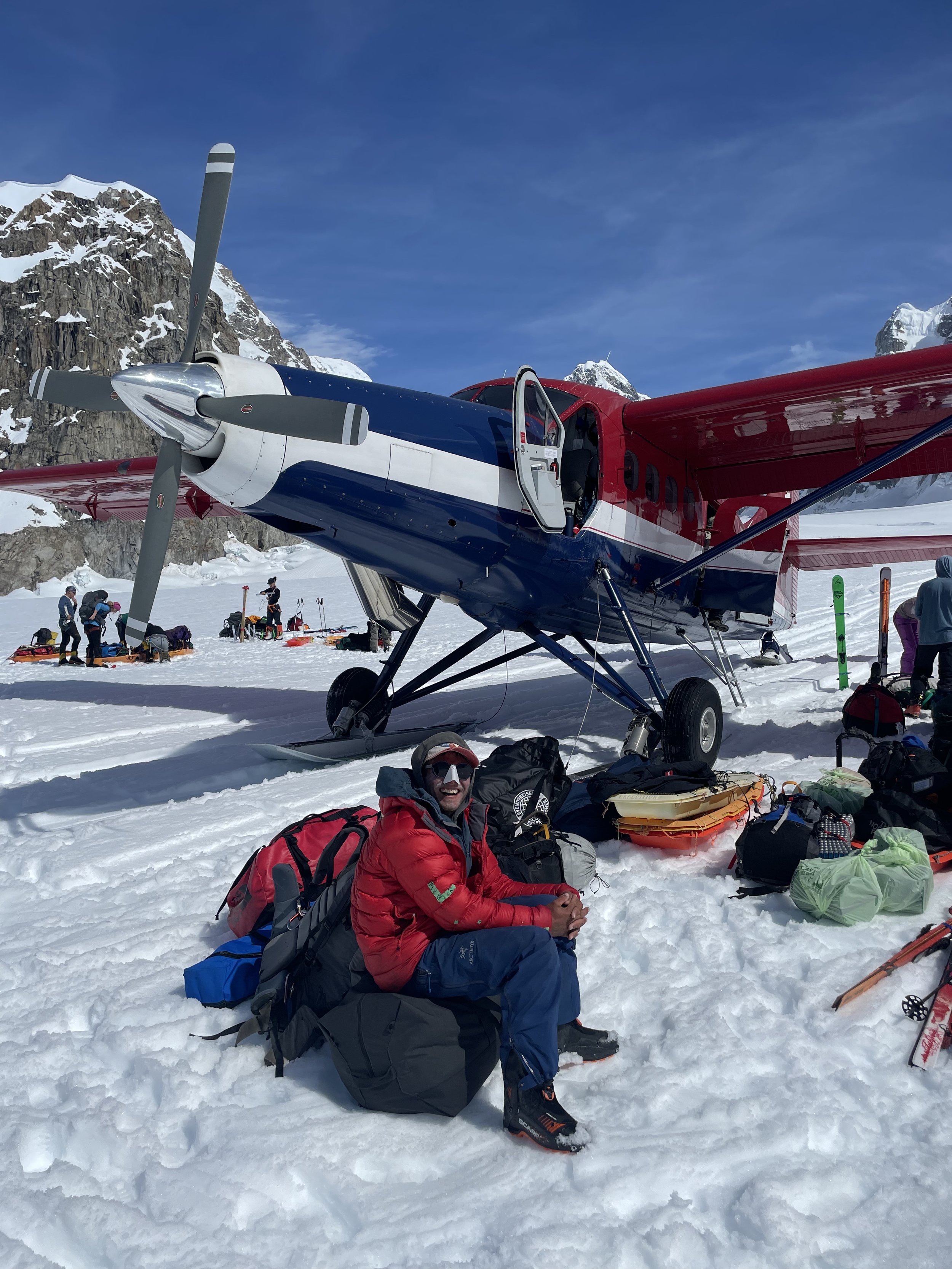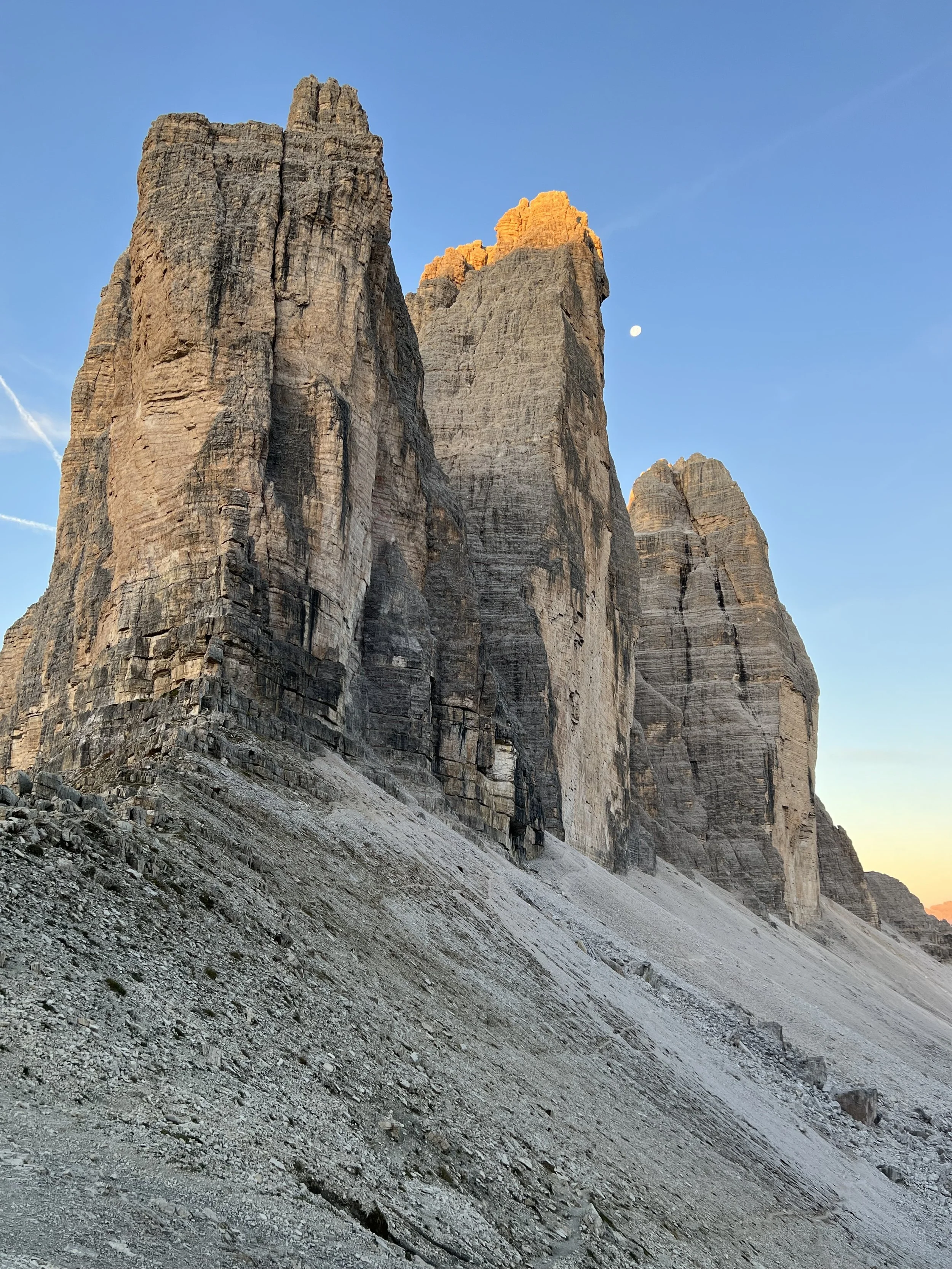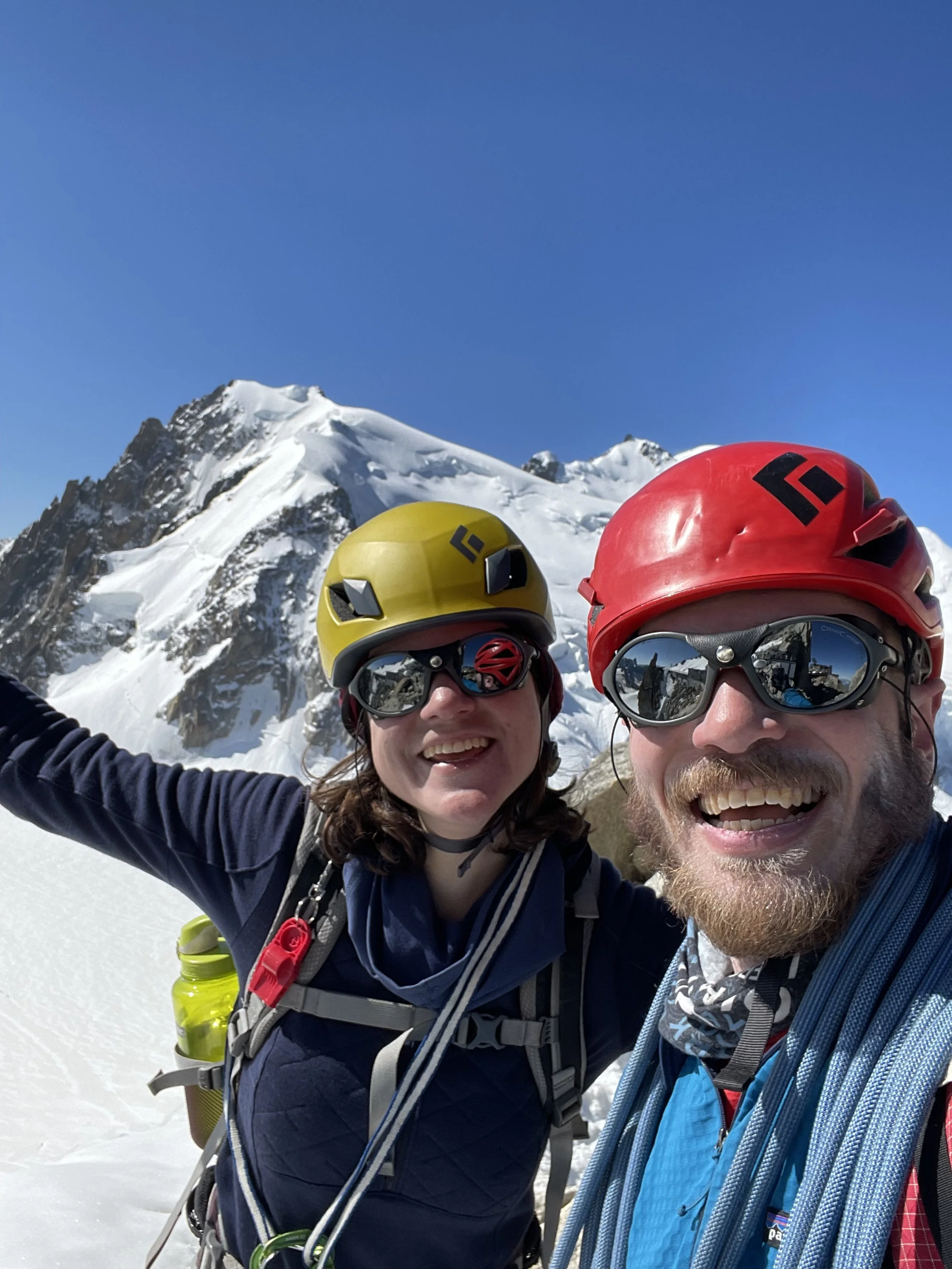The Cassin Ridge
We came up with the idea of going to Alaska after having too many beers one night at a bar in Chamonix. Nine months later John and I were topping out on the Cassin Ridge of Denali, one of the major alpine climbs of the world leading right to the top of the highest mountain in North America. Climbing here is like nothing else I’ve ever done, even the work to get yourself set up at 14 camp is equal to climbing a major mountain, and that’s only the start. But the work was incredibly rewarding. Hopefully this post helps some team out in the future, for either the West Buttress or the Cassin, both are incredible lines!
The Preparation
As you can imagine, prepping for a month in the Alaska range is a bit different than a weekend trip to the Gunks. I could do a whole post on training, but long story short I started training specifically for the Cassin as soon my summer season last year wrapped up. I was on a 6 month Uphill Athlete expeditionary mountaineering training program, I also trained for and ran a half marathon, and I was still climbing 2 days a week, less than the past but I still managed my hardest onsights on ice and trad in the 6 months prior to AK. And it should go without saying, this wasn’t my first time in the alpine :)
Outside of showing up fit, there is a lot of logistics to manage. The NPS has a great site outlining lots of it, especially covering the paperwork and permits. I also read tons of blogs, watched youtube videos, read the West Buttress book, and got advice from friends who have been there before. By early February all our paperwork was submitted and we had flights booked, and we started to pull together all the gear we would need. Our plan was to spend up to 28 days on the mountain, primarily on the West Buttress route, which would allow us to build safe camps and have quick access to higher altitudes for acclimatization. The main goal though was the Cassin Ridge, a prominent line splitting the south face of Denali, which we expected would take 3-6 days to climb once acclimated. Together this meant that we would need the full mountaineering expedition kit a WB team would need (4 weeks of food, 4 season tent, sleds, skis, tons of cold weather gear, ropes, crampons, ice axes, ropes, fuel, cook tent, giant packs, -40 sleeping bag, etc etc) as well as a climbing kit for a 8000’ alpine climb (rock and ice rack, alpine tent, technical tools, freeze dried food, lightweight stove, small climbing packs, more rope, lightweight sleeping bag, etc etc.) Preparing for the climbing part was easy and familiar, but trying to answer questions like “how many rolls of toilet paper do I use in a month?” or “how many packets of oats can we eat til we get sick of them?” is the hard part. Two days in Anchorage gave us plenty of time to sort this all out, and after catching a shuttle to Talkeetna we were ready to go into the mountains… with 316lbs of stuff to carry!
Lots and lots of food
Packed all our food into 2-person-2-day bags, which helped a ton with organization.
We had our NPS meeting the morning we left for the climb, and a half hour ride with Talkeetna Air Taxi put us on the glacier.
Just another commute…
It’s just like landing at JFK!
The West Buttress
The WB is by far the most popular route on the mountain, the park service says something like 85% of climbers use this route, but it sure looked like 99%. Even though we were early in the season (landing May 16) it was a bootpack the whole way to the summit. While busy, and not very technical, it is still really fun. Its a totally different scene than any other mountain I’ve been on, with lots of downtime hanging out with your neighbors and meeting really wild people as you acclimatize. It is also a really beautiful route, especially the ridges up high, and I would definitely recommend the experience.
Even though Denali is obviously a major mountain, I was blown away by how many incredibly inexperienced people were on the route. Large guided groups teaching self-arrest at 11 camp, families using bizarre rope systems and unaware of what ice screws are, it was wild. It really seemed that lots of people were coming from a backpacking and hiking background, rather than an alpine or mountaineering one. But at the same time there were also really cool climbers of all types from all over the world, and hanging out and sharing stories made rest days really fun.
For the route itself, there are a series of camps, any of them optional, that you slowly move up that get you into the basin at 14k where there is a sort-of “advanced base camp.” Most teams take about a week to get to 14 camp, several rest days then several days carrying loads to 17, and then a several day round trip to the summit, spending a night or two at 17 in the process. With a few extra days for weather, and to get out, it becomes a 3 week trip, maybe a bit longer if you add more rest or weather days in. On an average year, about half of climbers summit.
For our goals, we wanted to spend as much time as possible at and above 14 to acclimatize, so we pushed a bit harder than most in the first few days. We spent our first night at Ski Hill Camp, the next at 11 (this single carry might have been the hardest day of the trip), carried a load to 14 the next day, took a rest day, and then moved to 14. When we got to 14, the forecast for the next day called for low winds, so we decided to just go up and see how high we could get in order to push acclimatization a bit before a rest day or two at 14.
The sleds were awful to pull, every system had its own disadvantages. But they got way worse coming down…
One of the low camps, conditions were stable and people moving on quickly so it wasn’t fully established yet.
11 was where people started spending time. A “1000’ a day” strategy would keep you here for at least 3 days. We ended up spending a rest day because we were so worn from the single carry to 11, and a carry to 14 day here.
Our camp at 14, we ended up being here about a week. Every forecast for the first few days called for a “storm” about 3 days out, so we built up in case. This system ended up never coming through, which gave us the window we used on the Cassin.
Even on a day with a move or a carry, there is lots of downtime and time waiting for snow to melt into water.
We set off around noon, letting all the traffic get ahead of us on the fixed lines, which are a bottleneck just above camp. We didn’t have much in our packs, a few extra layers, some trail mix and bars, and about two liters of water total. We moved pretty quick up the fixed lines, and were across a beautiful ridge and at 17 camp in about three and a half hours. We initially said we should turn around in 5 hours and set at timer, but we cancelled it and decided to push on and see if we could get to the summit. We had passed Rob Smith and a friend a bit earlier and he encouraged us to try, given the great weather. Rob and his crew went on to climb the Slovak in 17 hours a few weeks later, pretty incredible.
We started moving slower past 17, and the Autobahn section wasn’t entirely kicked out, so we were taking our time. The Denali Pass section was beautiful and exposed, and it was definitely getting slower still. We took our last break at the base of the summit ridge, and topped out a bit later, 5 days 7 hours from sea level. And surprisingly, no altitude illnesses, thanks Diamox! Coming down felt really fast, and even though it was past 11 when we got back to camp it was still bright out and great visibility. Our round trip from 14 was 11 hours 10 minutes. We needed a couple rest days after this one!
Even though this was really fast from an acclimatization point of view, we had great conditions, we were both happy to turn around if the other wanted, we kept checking in, and we both felt strong the whole way, so it all felt safe. The views from the top were really phenomenal, you truly feel like you are miles above everything around. And I guess you really are, you have to travel to another continent to find something higher :)
After the fixed lines above 14 camp the route becomes incredibly beautiful. We’re traveling pretty light, since our goal is to acclimatize by climbing high, and we would turn around if any of us got tired or weather changed. John is even in his touring boots since he was checking out conditions lowed down.
We needed more frequent breaks, and were often at 1 or 2 breaths per step. It got slow, and you felt like you could o hard for a while, but you immediately hit a brick wall of breathing. But conditions were great and we wanted to take advantage of the perfect day. Who knows, it might have been our only summit shot if a big storm came.
The summit ridge had several false summits, and a wild knife edge, and then we were on top, all alone. The views were so wild, and really indescribable. And the air was so thin, less than half the pressure as sea level, where we were only 5 days ago.
The last belay
This is the view down to 14 camp from the ridge below 17, as we were coming down the Cassin, a week later. When we came down from our early season WB summit, 14 camp was about 1/3 the size. It got busy!
It is a really beautiful route
The Cassin Ridge
We took a complete rest day, started getting better at cooking with what we had (the key is to pan fry everything,) and dried out our equipment. The weather was still great, and it would turn out that this would be a massive high pressure system that led to a 66% summit success rate over the next two weeks, and a bunch of people climbing the Upper West Rib and the Cassin, and even a team on the Slovak. By the next day we were ready and just waiting for a good forecast. We had 18 days of food for here, and 4 more stashed at 11, and could easily cut rations a bit, so we were ready for the long haul if needed.
We made good friends with two neighbors, the Crackheads who were getting forecasts directly from a meteorologist who works in mountain weather, and a team called Too Hot Too Cold, made of friends from VT and CA who all had incredible backgrounds in climbing and careers, and careers that allowed for lots of climbing, who also were getting professional forecasts. For the next three days or so, these forecasts and the one from the rangers all more or less seemed to agree, that the next two days would be good, and then a storm system on the 3-5 day horizon. Not big enough for the Cassin. So after a few days of this, we woke up and get forecasts, and everything looked even better. The theme was “high pressure dominates” for 5 days out, with possibly gusty days the last two, but no precip. A team of Scots made the call first that they were going, and we followed. The Crackheads wanted to acclimatize more and catch the next one, and 2H2C started preparing for the WB summit.
Day 1: 14 to Cassin Ledge
We were already packed, and we planned on 3 bivies on route, given our fast pace on the WB lap, and we brought enough food for a 4th night, and enough fuel for water for another two days or so. We were feeling confident in the conditions, as two teams had climbed the route about 5 days earlier and reported it went great, and nothing had drastically changed on the mountain. We also knew we would get a good taste of the route by the top of the Japanese Couloir, and that we could bail from there if needed.
We were on our way around noon, planning on using the Seattle Ramp to get to the route, effectively climbing a few thousand feet up the to West Rib, and then downclimbing the bulk of that route into the Northeast Fork of the Kahiltna. The Scots (Ali and Al) had the same plan, and we passed back and forth sorting out the route through the seracs, and ultimately got down relatively easily. The last 30 meters or so was a steep face of rotten ice, and my calves were pretty burnt from all the front pointing, so it wasn’t exactly fun. The VoD was littered with debris, all the way up until the bivy ledge below the JC. We made it from 14 camp to the base in 5 hours.
I love downclimbing. About 4000’ of it took us to the base of the route.
There was plenty of daylight, and the Al’s were looking to bivy there, so it made sense for us to press on. Luckily John’s calves are significantly stronger than mine, and he led the whole way to the top of the JC, mixing pitches with microtraxed simul. The crux felt like WI4 to me, and I only “freed” it because of a very generous belay. But I was already really feeling what this route would bring, having to rest at belays and even on pieces multiple times, really getting the hardest calf workout I’ve ever had between the downclimbing and the route itself. Hard day1. But we were very much on schedule, and feeling good for tomorrow. I felt like I recovered really quickly at rests and bivys.
Crossing the bergschrund, now officially on route
The crux of the Japanese Couloir is a short vertical section of WI4 that John is blasting off into
Lots and lots of frontpointing
The bivy spot was incredible, the Cassin Ledge. This almost cave-like ledge, built up and leveled by the first ascent team, effectively overhangs the JC and the VoD. It is perfectly sized for a Firstlight, with snow nearby for water. But it was still very much big wall style living! Roped up the entire time.
The Cassin Ledge made an incredible bivy. It would be quite the squeeze for two tents though!
We cooked up our meals, and had time to enjoy the scenery. Lots of junk on this ledge, including fixed ropes from tons of early teams, it’s like some sort of time capsule, or an archaeology site that would have layers for different climbing eras. We went to sleep and didn’t bother to set an alarm, we could climb at any hour, and knew we had a good forecast and were on a good pace thanks to daily inReach messages from the Crackheads, so we decided to rest as much as we needed. Ended up getting about 8 hours of sleep each night on this route, pretty great!
Day 2: Cassin Ledge to base of 2nd Rockband
We woke up, cooked up a breakfast of oats, and packed up camp, and set off. We immediately got into the “5.8 crux” of the route, which definitely felt easy for the grade, and felt like fun easy mixed. From here we were at the base of the Cowboy Arete, a massive knife edge snow arete, that drops off forever on both sides. It truly drops thousands of feet each way. With bad snow conditions, this can turn teams around, but for us it went great. Nice sticky snow, and no hard ice, but that also meant no pro except for one picket we placed a couple times. Crossing over the ridge to chase the easier ground felt especially wild.
Giddy up!
The top of the Cowboy Arete
The top of the Arete is the only large natural flat spot on the entire route, a spot big enough for a couple small tents, so a popular bivy. It’s wild how steep the ridge is, nothing bigger than two tents for 8000 feet. We were still moving strong and continued on. The glacier above had large wall we had to climb. Luckily a team before us had left a track showing a way that seemed to work. Ultimately this turned out to be about a 20 foot vertical wall of ice, a bit garbage down low but excellent and sticky above. Felt like a great accomplishment to get through it, since this was one of the last “potential cruxes.”
More ice!
More steep glacier climbing got us to the first rock band. Luckily the calf workout wasn’t as bad, but the altitude was definitely slowing me down. This rock band consisted of a handful of pitches of icy gullys and easy 5th class mixed terrain, still challenging with packs and at altitude. We continued doing pitches and simulclimbing when the terrain allowed, and after about 10 hours on the move we landed right on a chopped out bivy ledge on a 45 degree ice slope at 15,960’. We thought about pressing on to a supposed good ledge a few hundred feet higher, but were happy with our progress and it was an easy decision to stop. Turns out that triangular roof spot was garbage, so it worked out great.
Trying to stay warm at 16k
Plush bivy for two!
Just like camping back home
The small ledge made for incredible campsite shots, it was pretty tight living! And we managed to dig to good ice for the anchor too. We cooked up our dinner and made water, and started to get better with the Reactor and keeping the tank warm with water. We had another great night sleep, minus getting showered in frost again in the morning from our frostlight tent.
Day 3: 2nd rockband to Upper Ridge
After a breakfast of oats mixed with some trail mix, mixed in our frozen Mountainhouse meal bags from the night before, we packed up and got going. We were soon in the 2nd rock band, a series of blocky gullys with the occasional steep pitch mixed in, including a few that had a reputation of slowing teams down. But we continued to have great conditions, and took breaks every few hours to eat and check out the views. Really started to feel like we were getting high once Hunter / Begguya was fully below us, and Foraker / Sultana’s summit was at eye level. The rock and snow quality was everything you could hope for the entire way.
Really fun mixed climbing in the rock bands
One of the last technical pitches, 5.6 at around 16k. Luckily the cruxes on this route are short, and well protected.
The altitude was really starting to get to me now, and the pack felt so much heavier than it was. It felt like I was at a total crawling pace, having to stop to catch my breath after any major “step” or pull of my ice axe. Even with feeling so slow, our pace was what we planed for, and passing several halfway decent sites but still feeling like carrying on in the upper slopes, we settled on one that needed some shaping but was pretty sheltered at exactly 18,300. This site might be the one described in the book at being at 18,100, but it is quite sheltered compared to others, and is under a prominent large triangular boulder. It was also blocky and low angle enough that we felt good enough to unrope, so no more sleeping big wall style. We did have to chop a ledge, but the winds started blowing a bit and it seemed to be the best spot to be.
The final bivy! This spot at exactly 18,300 might be the one called 18,100 on the topo? Really great spot, and pretty sheltered. We followed the ridge proper to find it, but it looked like other parties might skirt by on the left missing it. A few hundred feet higher were some other flat but exposed spots.
#glamping
The pace we were moving at was exactly what we wanted, and set us up for the summit and down to 14 the next day. I even thought we would have a pretty easy day tomorrow, compared to today, given the lower angle terrain. Who would have guessed it was going to be one of the hardest days I’ve ever had!
Day 4: 18,300 to Summit to 14 Camp
At this point out packs even feel a bit lighter at camp with most of our food gone, and we have very non technical terrain to go, so we’re optimistic. But it’s getting cold, and I spent this day in my puffy pants and big parka the whole way until the descent, so we’re moving slower right from the start. It got windy from time to time, but never enough to slow anyone down. A really high quality summit day. We even saw and waved to each-other with the Scots, who were about 5 hours behind us. In the end they used the opposite bivy sites as us, and it seemed like we had the better ones for the most part.
The last 3000 feet were absolutely brutal
I was getting incredibly worked at this point, and feeling like one of those horror stories of how hard the upper slopes can be for people. Every extra effort in any motion got my breathing skyrocketing, and I had to stop every 50 feet or so just to catch my breath. At one point it was three breaths per step, John counted that it took me 7 seconds at one point. But we kept going, John feeling much more fit and basically shoving shot blocks down my throat at one point, keeps pushing ahead. Absolutely one of the hardest days I’ve ever had, such a different type of exhaustion that I’ve never experienced before. But I was able to keep going, definitely slowing down John, but ultimately we made it.
Almost there!
Dropping the heavy packs, still about 35 pounds each, at the intersection with the West Buttress made it feel like I could run laps up and down the summit slopes. We quickly ate some food, and took the walk up the last few hundred feet to the top.
It was the same summit as a week before, but it felt different. The lighting was totally changed, and the snow had been so tamped down that it felt more like a summit platform. It was also windier, one forecast called for a summit high of -16f and winds of 25-35mph, so giving a windchill below -40. And we also felt like we climbed something much bigger, and it felt so incredible to have climbed the route in such great condition, in what I felt was great time and style.
#summitselfie
We made it
Summit of Denali, Cassin Ridge, 29 May 2022
We headed down to 14 really quickly, and passed several familiar faces who were on their way up the WB, including the whole Too Hot Too Cold team, A Canadian crew from near Squamish, and Inge from Norway, who all got to the top.
We got back, feeling so much better now that we were moving down, and got to 14 camp by the middle of the afternoon, more or less the fourth 10 hour climbing day in a row. That doesn’t sound bad, but it was incredibly hard with the elevation, and elevation gain. With the sun still shining we cooked up a celebration dinner, starting with an entire package of bacon as an appetizer, followed by a mixture of anything that looked delicious.
Victory bacon! The vegetarian diet went out the window for this trip.
Getting Down
We took a full rest day, and had a really fun time cooking as much food as we could communally (tortillas were the winner, especially ones with chocolate) and hanging out with the other Cassin teams, the Scots who just topped out, as well as Michelle and Fay, who would get the only all female ascent of the year about a week later. The Crackhead team, who had been incredibly helpful sending us messages on the inReach (the one I didn’t drop) throughout our climb and sending encouragement had already set off for their own ascent, which they were successful on as well.
We tried to cook everything we could so we wouldn’t have to carry it down. Chocolate filled fried tortillas were a hit!
Michelle and Fay made the season’s only all-female ascent of the Cassin about a week later!
After the full rest day, we packed up along with 2H2C, and struggled to get to 11 camp with the sled. It was frustrating, but the skis made it worse we thought with the steeper terrain, and hoped the next day would be much easier. Then we had the mentally hardest day of the entire trip, going downhill with sleds that want to run you over every other step, for basically the distance of a half marathon. We tried every tactic, redistributing weight, using brake ropes, tensioning with prussiks, using leashes, and every time we hit the slightest bump or slope the would tumble or hit you. At least thats how it felt. John had it far worse than me, his sled just would not stay properly. It also didn’t help that the lower glacier was melting out in the daytime, so we were going since 2am on only 3 hours of sleep. In the end, the downhill came to and end, and the Heartbreak hill almost felt like a relief because the sleds didn’t flip on the uphill. By the time we arrived, June 1 and only day 17 on the mountain, the runway was melting out, something that normally doesn’t happen until July apparently.
What the last two days felt like moving gear back down the mountain
So we had one more mini heartbreak hill to the upper runway, where we shared a full bottle of whisky with the crew from Norway and one from Jackson waiting for our plane to come.
Irish coffee for breakfast!
Mission accomplished
Almost home!
We got back to Talkeetna, booked an apartment and each took an incredible warm shower, got through the headaches of switching flights, and got to drinking! After a bunch of rounds with the Canadian team at the Fairview, we were hungry and nothing was open, because thats what happens at night when you are’t in Brooklyn. So the only answer was to head back to the apartment, and cook up some freeze dried. It was a really fun way to end the trip. Another couple travel days, and more time drinking with 2H2C in Talkeetna and Anchorage, and we were home, far ahead of schedule.
In the 10 years before 2020, an average of 11 people a year climbed the Cassin, compared to an average of 573 on the WB. It seems like 17 people on 8 different teams climbed it so far in 2022, plus 6 climbers on the Slovak. A relatively a busy year, thanks to this long lasting stable weather system, but all the teams also sounded ready to wait any weather out as well.
Overall this was one of the hardest things I’ve ever done, putting the fitness and all the alpine skills together to climb one of the coolest looking lines on the planet going straight to the top of North America. The days on route were exhausting, but incredible climbing in the most beautiful terrain. Possibly the best bivy sites I will ever have. And really incredible and fun people. Definitely excited to come back to the range again. But maybe without sleds.
Food & Gear List
West Buttress Notable Gear:
40 Below Booties: must have!
Cook tent: also must have, even just a tarp for over a pit
Multiple solar chargers and batteries (especially if using phones for music, movies)
Backup options for music. Apple Music decided we needed to connect to the internet halfway through the trip to reenable our accounts… lovely
Kindle with LOTR
Frying pan, lots of tortillas, and butter to fry things in
Extra chocolate
Radio for emergencies, forecasts (we didn’t have one, but this is probably the main thing I would add for next time)
A good camera
Stuff to keep your face covered 100% the time the sun is shining, or else you will sunburn
Skis, skins, and ski crampons (thanks Viktor for letting me borrow!): to at least 11, 14 if good conditions, even if you are a terrible skier like me. It is so much more efficient than snowshoes, and fun
Cassin Ridge
Sleeping:
BD Firstlight, and a few snow anchors
Feathered Friends Peregrine EX -25F (~-30C) sleeping bag, John in -40 Sea to Summit (thought about brining our -10s, but the forecast was for cold nights, glad went heavy since we slept great)
Thermarest Neoair Xtherm
Foam pad as backup (maybe skip)
Wearing:
Crampons: BD Snagletooth w/ wide bail, John in Grivel steel dual vertical front points and aluminum heels
Boots: La Sportiva Spantik (carried overboots, heavy, never needed) and John in Scarpa 6000
Socks: Smartwool x2 switched daily
Lower base layers: 2x Smartwool leg base layers worn together
Pants: Arcterex Goretex Alpha SL (would have been nice if they had pockets!)
Puffy Pants: Mountain Hardware Compressor (worn at bivys and on summit day)
Upper Base layer: Smartwool
Sunshirt with hood: Icebreaker
Fleece: Arcterex Rho AR zip (would have been nice if the pocket fit an iPhone!)
Puffy: North Face summit L3
Parka: Feathered Friends Khumbu (worn at bivys and on summit day)
Light gloves: OR Glove Liners
Climbing Gloves: BD Terminator & CAMP Geko Hot
Heavy Gloves: BD Guide
Mittens: OR Alti, never wore, but would bring in case
Glacier glasses: 2 models of Julbo, both had side eye guard issues
Ski goggles: Smith, never used, would bring again in case its windy
Buff
Balaclava: Smartwool
Hat: Homemade by Janice!
Helmet: Petzl Meteor
Nose cover: The one everyone now has from Amazon
Cooking:
MSR Reactor stove
Emergency ultralight stove (BRS-3000T)
3 Medium fuel canisters (used ~1.5)
Empty MH meal bag to hold the canister and water to keep it warm (this was the ticket!)
Lighter and striker
Sporks
1 nalgene each with 40 below insulation
1 40oz hydroflask for sharing
Food:
7 Mountain house meals (1 per person per dinner for 3 days, plus one to share for a 4th if needed along with leftovers)
Extra dinner snacks (precooked bacon, dried mango slices, jelly beans, etc)
Trail mix (~2 handfulls per person per day for 4 days, a bit more than needed)
A few bars/shotblocks per person per day, or cheese and meat sticks
1.5 packets of oats per person per day for breakfast
Instant coffee mixed with instant milk
Tea
Emergen-C and other drink flavors
Climbing:
Pack: Cilogear 45L MOB WorkSack
Harness: Camp Alpine Flash with DMM clippers
Rope: Mammut Alpine Sender: 7.5 60m half/twin (brought 1)
Tools: Nomics for me, Grivel Dark Machines for John, 1 adze each
Leashes: Cassin (of course!)
Screws: 8 (happy we had that many, JC was icy)
Cams: BD Ultralight 0.4, 0.5, 0.75, 1
Wires: ~10 DMM offsets
Picket: 1 (used on cowboy arete for pro, and bivys for anchor)
J Snare V thread tool (never used, but would be key to getting down the JC)
~8 alpine runners and ~4 double lengths with Camp Nano 22s
2 Microtraxions
Belay device
A few lockers
~7m of tat (not used)
2 inReaches (dropped 1, if anyone finds it somewhere in the JC or VoD let me know! Also, would bring radio for comms / forecasts from NPS)
iPhone and Android with Gaia, maps downloaded, and 4G internet above ~17k for the iPhone with Verizon
Map printout & compass (never used)
Single ski pole each (descent only for the most part, but nice to have)
Misc
First aid kit with altitude meds (Rx including dexamethasone, nifedipine, plus the standard OTC stuff)
Toothbrush (had to)
Toilet paper, alcohol wipes
Duct tape, thermarest patches, bailing wire, and Leatherman Skeletool (never used, but wouldn’t go without)
Sunscreen
Chapstick
Cameras


